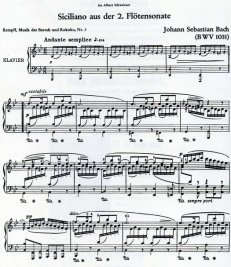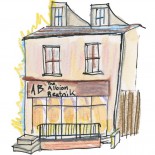The Albion Beatnik Bookstore website (or how to change a light bulb in a tight space on a ladder)
The web page of the Albion Beatnik Bookstore, based once in Oxford, then Sibiu, always neo-bankrupt, now closed for business: atavistic and very analogue, its musings and misspells on books and stuff.
Siciliano, Spirituality & Saccharin
 The mid-twentieth century vogue for transcribing Bach chorales or instrumentals for the piano was a meeting point of nostalgia and aspiration, perhaps sounding boards to reflect hope against the political crudity of their time. After the First World War many virtuosi succumbed to performing self-penned, perhaps more personal transcriptions of Bach – Alfred Cortot, Alexander Siloti, Egon Petri, Myra Hess, Harriet Cohen made arrangements, others too. The modern piano’s virtues (or, in the case of Godowsky’s transcriptions, its excesses) could be employed without academic questioning: a sustain pedal, different tonal voicing, its wide range and heightened dynamic.
The mid-twentieth century vogue for transcribing Bach chorales or instrumentals for the piano was a meeting point of nostalgia and aspiration, perhaps sounding boards to reflect hope against the political crudity of their time. After the First World War many virtuosi succumbed to performing self-penned, perhaps more personal transcriptions of Bach – Alfred Cortot, Alexander Siloti, Egon Petri, Myra Hess, Harriet Cohen made arrangements, others too. The modern piano’s virtues (or, in the case of Godowsky’s transcriptions, its excesses) could be employed without academic questioning: a sustain pedal, different tonal voicing, its wide range and heightened dynamic.
 Wilhelm Kempff was born in 1895; he died aged 95. He was feted for his interpretation of the nineteenth century Germanic repertoire and was much recorded (two complete sets of Beethoven sonatas, for instance, in mono and stereo, as well as a near complete cycle on shellac). For much of his career he was hidden from the English speaking world: his first recital in England was in 1954, in America in 1964. Schnabel held him in great esteem: he requested of EMI that if he himself failed to complete his recording of all Beethoven sonatas, they were to second Kempff to record those remaining, even though far more lyrical and spontaneous than Schnabel. Brendel wrote that Kempff “played on impulse… it depended on whether the right breeze, as with an aeolian harp, was blowing.”
Wilhelm Kempff was born in 1895; he died aged 95. He was feted for his interpretation of the nineteenth century Germanic repertoire and was much recorded (two complete sets of Beethoven sonatas, for instance, in mono and stereo, as well as a near complete cycle on shellac). For much of his career he was hidden from the English speaking world: his first recital in England was in 1954, in America in 1964. Schnabel held him in great esteem: he requested of EMI that if he himself failed to complete his recording of all Beethoven sonatas, they were to second Kempff to record those remaining, even though far more lyrical and spontaneous than Schnabel. Brendel wrote that Kempff “played on impulse… it depended on whether the right breeze, as with an aeolian harp, was blowing.”
Without doubt the bedrock of Kempff’s musical life was Bach. By the age of ten he could perform from memory all of the 48 Preludes and Fugues, and astonishingly as a party trick he was able to transpose and perform each into any key (as can Barenboim); he returned to Bach late in life with a cycle of dramatic recordings. From the 1930s – though published only in the early 1950s – he arranged ten Bach chorales and three Bach instrumentals. He had admired greatly Busoni’s much more florid transcriptions of Bach (he had lessons from Busoni when a child), but Kempff’s remain faithful to the original score and (mostly) humble in their approach to the keyboard, respectful to Bach’s vision. He had admired Busoni as much for his spirituality as for his arrangements, which, remarked Kempff, explain the transcriptions’ profundity. Kempff’s arrangements of Bach, too, had an almost devotional aspect for him; he was a Lutheran and a fine organist, as had been his father (a church minister) and grandfather professionally.
 The most well-known of Kempff’s Bach transcriptions is the gentle and flowing second movement from the Bach Flute Sonata in Eb major, a siciliano in G minor. (There is scholarly fisticuff as to whether this is an original Bach composition; it could be a more complex reworking of an earlier flute sonata by Quantz.) Kempff recorded it first in 1931, but as though he’s on tiptoes to avoid echo on the cathedral floor, mannered, slow and processional. His 1953 recording is nearly beautiful, polished but a trifle too corporeal, like a serviced car purring in first gear. A 1975 LP of his Bach transcriptions is a strange delight that at times echoes like a church organ, his Siciliano here is a revery slightly romanticized, and its conclusion is unsatisfactory. But it is Dinu Lipatti’s 1950 recording that soars above, fearless, without stutter, fluttering like an angel in the cathedral vaults: it whets a pang for fulfilment and excites an aftermath of wonder. Kempff’s grace becomes Lipatti’s Divine favour.
The most well-known of Kempff’s Bach transcriptions is the gentle and flowing second movement from the Bach Flute Sonata in Eb major, a siciliano in G minor. (There is scholarly fisticuff as to whether this is an original Bach composition; it could be a more complex reworking of an earlier flute sonata by Quantz.) Kempff recorded it first in 1931, but as though he’s on tiptoes to avoid echo on the cathedral floor, mannered, slow and processional. His 1953 recording is nearly beautiful, polished but a trifle too corporeal, like a serviced car purring in first gear. A 1975 LP of his Bach transcriptions is a strange delight that at times echoes like a church organ, his Siciliano here is a revery slightly romanticized, and its conclusion is unsatisfactory. But it is Dinu Lipatti’s 1950 recording that soars above, fearless, without stutter, fluttering like an angel in the cathedral vaults: it whets a pang for fulfilment and excites an aftermath of wonder. Kempff’s grace becomes Lipatti’s Divine favour.
And, for fun, this is the great jazz pianist Bill Evans’ version recorded in 1966 simply called Valse (ha! to be pedantic a siciliano has two beats each bar, though each divided in three). Bill Evans had brought discernment to jazz piano; he was the pianist’s pianist with an ethereal touch and translucent vision. Bill Evans Trio with a Symphony Orchestra is lambasted frequently by the jazz posh, held to be musical nylon or half-heartedly third stream. But I think it is a great album, peculiarly one of his best; Claus Ogerman’s arrangements are beautiful and haunting, and they allow the Evans trio, always inventive, to float above the mawkish string orchestra rather than sink into its saccharin. (Evans approved of this album, and he was his own harshest critic.)


